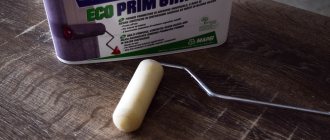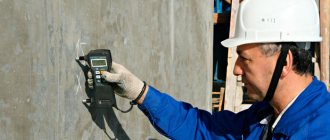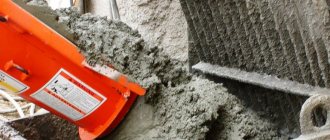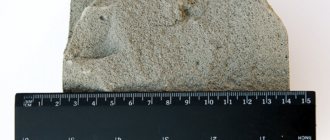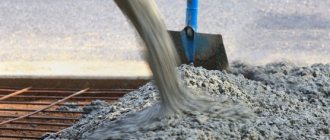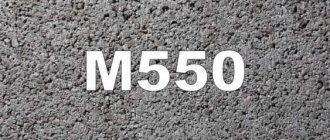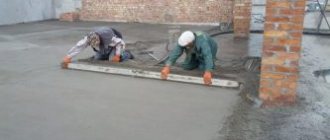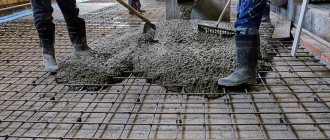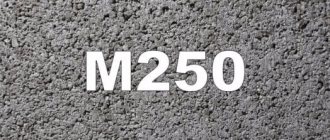There are several types of primer, but it is best to choose the best and already proven material, which has excellent reviews from its customers. To do this, you need to understand exactly how different types of primers differ from each other.
The most common type of primer is the one that has the deepest penetration. This is explained by the fact that a primer with exactly these characteristics can withstand the most unfavorable conditions and maintain a presentable appearance for a long time.
Pros of using primer
According to user reviews, the positive aspects of the primer material are the following:
- the property of the treated surface remains unchanged;
- the service life of the base is extended;
- during repairs, the base and finishing materials are secured more firmly;
- primer for concrete acts as an insulator, eliminating the possibility of contact between materials that are not suitable for each other.
Recommendations: some types of primers can be used as a material that is suitable for the final stage when finishing surfaces.
Characteristics of common soils
Despite the wide selection of primers, not all are popular. The scope of application of some mixtures is limited by specific conditions of use. Let's consider the characteristics of the most popular compositions.
Polystyrene
The mixture is classified as protective and is used for outdoor work. Its task is to increase the resistance of the concrete surface to external influences. As an additional characteristic, it is worth considering the ability of the composition to increase adhesion with all types of ceramic coatings. Polystyrene primers are recommended for use with tiles and porcelain stoneware, under plaster. It is advisable to use them when finishing industrial premises.
Acrylic
Primers of this type are considered to be as environmentally friendly as possible. They are recommended for indoor work and can be used when finishing areas that are subject to increased requirements. The acrylic mixture penetrates deeply into the concrete, increasing its strength.
Deep penetration
Mixtures of liquid consistency, based on latex, acrylic, polyurethane components, alkyd or epoxy resins, which provide a penetration depth of up to 1 cm. The porous structure acquires high strength, moisture does not penetrate inside it, and this is a guarantee against the formation of mold and mildew. A dense layer with moisture-repellent properties is formed on the concrete surface, which lasts for a long time.
Polyurethane
Primers of this type provide high protective and water-repellent properties. The mixtures do not contain components hazardous to health, they are environmentally friendly, and can be used for indoor and outdoor decoration. Recommended for use before applying paint or whitewash. They increase adhesion between the concrete base and the finishing material (plaster, putty, self-leveling floors, paints). Can be used as a decorative impregnation (used as protection and strengthening of concrete floors).
Concrete contact
A primer mixture that can significantly increase adhesion. It contains additional components: quartz sand or marble chips (the choice of fractions depends on the final layer). The water-dispersion composition penetrates deep into the concrete structure, which simultaneously increases the strength of the base. The primer is recommended for perfectly smooth or porous coatings.
Polyvinyl acetate
A universal composition that, to an average degree, performs various functions: protective, increasing adhesion, water-repellent. Its only undeniable advantage is the short drying period. Half an hour after application, you can continue working on the formation of the floor covering.
Alkyd
Alkyd-based primers are deep penetration mixtures. They interact well with paints and varnishes. The compositions are recommended for use under painting. An additional property of the primer is that it is water-repellent. After application and drying, the surface is reliably protected from moisture penetration and, as a result, from the formation of mold and mildew. The scope of application is mainly construction.
Epoxy
The main component is epoxy resin. When interacting with a hardener and after drying, it forms a durable surface. Primers are recommended to increase the strength of the concrete base before painting or pouring a self-leveling floor. This primer can be used to cover: facade walls, metal structures, brick, stone, drywall and anything else where a reliable primer is needed. Can be used as glue.
The Steamline company produces various types of primer compositions. The use of high-quality raw materials from well-known manufacturers allows us to guarantee the high quality of the products offered. The company's specialists perform work on priming concrete surfaces using their own products and provide a guarantee on the completed order. When concluding an agreement for a range of services, individual conditions are considered under which the client can count on a discount.
Brands of soil manufacturers known for their compositions
On the market, due to their quality, such manufacturers deserve attention as: Knauf, Prospectors, Politek, Optimist, Tex, Ceresit, and of course we are Streamline Chemicals. Our advantages - we have been producing and selling construction and finishing materials for more than 15 years. During this time we have received only positive reviews.
Preparing the base
The surface, for which concrete of the appropriate quality was used, is characterized by a finely dispersed structure, due to which it is ideally smooth (for example, floors made of concrete slabs, as well as panel houses). However, it should be noted that on such a base there is simply nothing for glue and putty to cling to; they do not fit well.
Eventually:
- the wallpaper quickly begins to peel off;
- the putty is subject to peeling;
- Cracks appear on the plaster.
If the finishing is carried out by highly qualified specialists, then even before the start of repair work they determine the characteristics of the surfaces.
If the previous finish has a large number of various types of damage, this indicates that the walls have not undergone the necessary treatment; preliminary preparatory work has not been carried out, which includes cleaning the surface and priming the concrete.
Varieties
All epoxy-based primers can be divided into two groups:
- compositions for metal surfaces;
- compositions for concrete bases.
It is worth understanding in detail the features of each type.
For metal surfaces
Such primers are very reliable; they are even used for surface treatment at industrial facilities. If you want to choose a composition that is of good quality, you need to know what it should be.
Advantages of compositions for metal
High-quality materials for metal surfaces have the following advantages:
- Coatings must reliably protect surfaces from mechanical influences and provide abrasion resistance. A sign of unreliability and poor quality of the primer is low coating strength.
- If you focus on the standards, it can be noted that the primer must protect the surface from corrosion for five years (no less). Of course, this can only be achieved if the base is carefully prepared before applying the material.
- High-quality epoxy primers for metal surfaces are resistant to petroleum products.
Thanks to this, they can be used at gas stations, workshops and other similar places.
- Good epoxy primers are resistant to alkalis and acids. This is a very important advantage: it guarantees that the foundation will be reliably protected even if unforeseen circumstances suddenly arise.
- The dried coating must be absolutely safe for human health. Such materials are always certified and are subject to very strict requirements. If there are no documents confirming the quality of the material, it is better not to purchase it. Otherwise, you may end up with a low-quality primer that will not provide reliable surface protection.
- If you are not sure that you can navigate the variety of materials on the modern market, it is better to get advice from an experienced specialist. It is also worth trying to get as much information as possible about the manufacturer of the primer composition you are interested in.
- In cases where you need to use an epoxy primer indoors, it is better to opt for a solvent-free option. This will allow you to apply the primer without fear of poisoning. In other cases, formulations with solvents are quite suitable: they are usually of high quality and more affordable.
- Epoxy primer is compatible with many paint compounds. Thanks to the versatility of such materials, you can be sure that the result will not disappoint.
Other distinctive features
Epoxy primer for metal is most often applied in 3 layers. This amount of primer material is quite enough to provide reliable surface protection for several years.
Two-component primers for metal surfaces. They consist of components that help improve the protective properties of the coating and increase its strength, as well as an epoxy base. It is necessary to add a hardener to the solution.
For plaster and concrete
Such primers are divided into two-component and one-component. It is worth understanding in more detail the characteristics of each type.
One-component
These primers have the following features:
- Ease of use. You will not need to worry about how to properly prepare the solution. You don’t have to think about the accuracy of proportions: such materials can be used immediately.
- One-component primer compositions are fireproof. You don't have to worry about the coating catching fire.
- Such coatings protect wood surfaces from exposure to liquids. You can avoid buying impregnation - and thereby save money.
- These primers provide good adhesion. With the help of a one-component primer, it will be possible to prepare even surfaces that do not absorb well: painted structures, ceramic bases, and so on. Similar compositions are suitable for PVC and linoleum.
Stages of surface cleaning and primer application
1. Before applying the primer to the base, it is recommended to thoroughly clean it with your own hands from the previous coating, where, most likely, unnecessary dust has accumulated.
2. All existing defects (cracks, irregularities) on the surface must be completely eliminated.
3. Next, a deep penetration primer for concrete should be applied to the base, which will help strengthen the damaged areas.
4. After completing the above steps, the base should be leveled.
It is also recommended to prepare them before painting the walls. A deep penetration primer for concrete is also used for this.
Recommendations: to protect the surface from microorganisms that can cause harm, you should use a primer that contains an antiseptic. It is used when treating external walls of buildings, as well as in rooms with high levels of moisture.
Selecting an adhesion promoter
So how do you decide on the choice of primer? It is necessary to understand that this building material is a mixture of acrylic polymers, each of which imparts certain properties to a specific composition. Main technical indicators of primers:
- depth of penetration into the surface;
- consumption rate per m2;
- complete drying time;
- color of the liquid composition;
- presence of odor;
- range of application and storage temperatures.
The technology for applying a primer differs little from conventional roller painting. For deeper treatment, the impregnating composition can be diluted with water and applied in stages in several layers. It is difficult to definitely recommend a brand of primer for concrete, since it is necessary to take into account not only the base material, but also the type of finishing coating.
For large volumes of work, an important factor in the choice will be the price of the strengthening composition. The most popular deep penetration primers in Russia are Ceresit and Optimist. The German material has a complex composition and has a number of advantages in preparing a concrete base, but is much more expensive.
Now the construction industry offers a fairly wide range of primer materials. The composition should be selected taking into account the opinions of professionals (work performers) or after carefully weighing all the justifications. We can only recommend one thing - price should not be the deciding factor. It's better not to skimp on quality.
Applying primer
When applying this material, you must use a roller or brush.
In addition, do not forget about the product consumption recommendations that are on the packaging:
- Due to its properties, the surface is not able to absorb more than the specified amount of primer. Excess material will simply dry out without bringing any benefit.
- If you apply less than the required amount of primer, this will also not be of any benefit, since it will not penetrate inside the base and, accordingly, will not be able to strengthen it.
Recommendations: Before applying the primer, work on the base and walls should be completed.
Why do you need a primer?
Even the most expensive finishing material can peel off over time, tiles can fall off, and wallpaper can begin to bubble. A primer will help to avoid such troubles, playing an important role in the service life of the decorative coating, and indeed the base itself. It provides:
- improved adhesion between layers;
- increased resistance to water and alkalis;
- greater strength of the base;
- high-quality preparation before further installation of coatings;
- uniform application of subsequent layers.
Everyone knows that surfaces made of mineral materials such as concrete and brick are susceptible to destruction under the influence of external factors, especially moisture, which their porous structure easily absorbs. When freezing, in this case, the surface simply breaks. As a result, there is a gradual destruction of the entire building structure.
Primer for concrete protects the material from negative influences, while maintaining its sufficient vapor permeability and ability to “breathe”.
The primer also allows you to reduce the consumption of decorative material applied on top due to its less penetration into the pores of the concrete. In addition, in the absence of soil, the putty is quite difficult to distribute over the surface of the base, quickly dehydrating and becoming less plastic.
Types of primer
The material is intended for processing internal and external surfaces. A concrete primer for exterior use can equally well be used for interior use. However, due to the fact that the composition includes components that pose a danger to the respiratory system, after using it it is necessary to properly ventilate the rooms.
The following varieties exist:
- Strengthening concrete primer with deep penetration.
- Textured, which include fillers. They are used for subsequent work with surfaces (for example, acrylic primer for concrete).
- Insulating. They protect against the adverse effects of climatic conditions, chemicals, and mechanical influences (these include silicone, polyurethane and epoxy primers for concrete).
- Primers containing antiseptics: protect against mold and mildew.
Depending on the type of surface, primers are divided into:
- Primers designed for smooth surfaces (they serve as protection against moisture and are used for painting or plastering).
- Primers intended for cellular concrete (characterized by good viscosity, they contain silicate fillers designed to fill pores). They are perfectly absorbed, but weakly strengthen concrete.
The instructions on the packaging of the material indicate for which surface the concrete primer is intended - for external use or for internal use.
Primer function
Figure 1. Applying a primer for concrete
Any concrete surface is prone to gradual destruction. They are influenced by many factors that negatively affect the condition of the building material. Thanks to the use of a primer, it is possible to significantly slow down any negative processes. Primers have the following abilities:
- Ensuring uniformity. Thanks to the use of soil, a uniform coating can be achieved. Such compositions penetrate even into small pores, thereby leveling the surface. Next, any building compounds can be applied to the treated wall.
- Ensuring the maximum level of adhesion between building materials.
- Creating a durable surface on concrete. A concrete primer helps minimize the risk of walls peeling off in chunks in the future.
- Protection from adverse environmental factors such as chemicals, bacteria, mold.
- Saving on construction material consumption. The primer penetrates and evens out all pores.
- Preventing excessive moisture in concrete, ensuring waterproofing.
Expert advice
When choosing soil:
1. It is necessary to identify why the composition is needed (to prepare the surface for plastering or painting, for waterproofing).
2. You should know what material the base is made of (fresh or old concrete, whether it is dense or cellular). Based on this, you should choose a primer with the appropriate characteristics.
3. It is necessary to calculate the primer consumption.
Recommendations: it must be remembered that the composition is not capable of strengthening concrete, therefore it should not be added to the solution.
The maximum penetration depth is 70 mm, which creates a protective layer. This material, like a bumper, takes the entire impact, performing the function of protecting the base.
A base treated with a primer will retain its properties much longer and better. But if this material is added to the solution, it will not become stronger without the use of additives specially designed for this purpose.
Recommendations: unreasonable use of soil in concrete can reduce the strength characteristics.
In order to add special components to a concrete solution that can enhance its strength, you must have a special construction or engineering education.
The need for primer
Anyone who has ever carried out renovations in their apartment knows perfectly well that before the walls are puttied, painted, or wallpapered, they need to be covered with a layer of primer (and maybe more than one). The same must be done before laying the flooring. But not everyone will think about why this is being done.
The main task assigned to the primer is to increase the adhesion of the concrete surface to subsequent finishing materials. In addition, the mixtures provide protection from the harmful effects of a number of external factors.
The material in its already frozen state is quite durable. However, if additional means such as a primer are not used to strengthen the concrete, it may collapse. This may be due to mechanical reasons. Concrete is also affected by natural external factors.
Recommendations for application
Epoxy primer mixtures should never be used on wet surfaces. The permissible base moisture level is no more than 4%.
The process of applying an epoxy solution to the base will consist of the following steps:
- Preliminary preparation of the base, which must be thoroughly cleaned of dirt, dust, and old coatings. The base must be cleaned of any oil and grease stains, traces of substances of various origins. If necessary, the base can be washed, but in this case it will need to be completely dry before starting priming.
- The technology for preparing the epoxy primer for use will depend on what specific type of material was purchased. One-component mixtures are simply mixed thoroughly; for two-component soil, a different preparation procedure is provided. You should open the package with the resin component and mix it with the hardener. The proportions of the solution are given by the manufacturer in the instructions for use, and you cannot reduce or increase them at your own discretion! Such amateur activities are fraught with the loss of useful properties of the soil.
- The components of the solution are mixed with a mechanical stirrer until a mass of homogeneous consistency is obtained, which must be used immediately.
- Epoxy primer can be applied using a variety of tools; instructions on what type of tool is best to use in the work can be found in the instructions for the specific type of solution. Most often, manufacturers advise distributing the primer over the surface using rollers, spatulas, graters, or a spray gun.
- The material is poured onto the base in a thin layer and carefully distributed with a tool recommended by the manufacturer.
You need to work quickly with epoxy primers and avoid the formation of puddles during the work.
- Two-component solutions set quickly enough, so after preparation the primer must be applied to the base as quickly as possible - in about 20 minutes. Therefore, it is not recommended to prepare the solution in large quantities.
- High temperatures can negatively affect the beneficial properties of the soil mixture, so in hot weather the solution should always be prepared in small quantities required to complete a specific stage of work (portions no more than 3 kilograms).
The soil will harden for about a day. The information on the permissibility of walking on the created coating should be clarified in the instructions for use for a specific brand of primer.
The need for re-priming with an epoxy primer is determined visually. If the solution is completely absorbed (this is possible with increased porosity of the base), without forming a noticeable and shiny film, or bubbles and holes appear on the surface of the coating, it is necessary to apply the solution in at least one more layer.
When working with the solution, you must follow certain working rules. It is better to protect your skin and eyes with special clothing, wear gloves and goggles. If areas in a closed space are treated with epoxy primer, it is important to ensure good ventilation in the room.
Epoxy primers for concrete are a material the use of which helps to properly prepare surfaces for further finishing work. The finished base is reliable, super-strong, resistant to wear and negative environmental factors. Therefore, epoxy primers remain in demand in the construction market, despite the rather high price of the material.
Zinc-containing two-component primer compositions
For cars, if the frame and other structural elements are made of alloys that do not contain zinc, two-component epoxy primers with the addition of metallic zinc, which protects the iron in the steel from corrosion, are useful. To improve the protective properties of such primers, orthophosphoric acid is also added to them, which prevents rust.
They form a separate group of epoxy primers. They are used for frames and strength elements of car bodies during their production on an assembly line or during repairs in auto repair shops, if the metal composition does not include the use of zinc as an alloy. They are used in aggressive environments, which are sufficient during vehicle operation, both in the city (chemical reagents for melting snow and ice) and in the countryside, in the absence of roads (dirt, acidic or alkaline water, abrasive effects of sand or any other soil) .
Such a protective coating, after complete curing, is capable of protecting the metal of the body for 10 years, if the integrity of the layer has not been damaged as a result of mechanical impact (impact or strong friction against the ground or a stone surface). In combination with other protective layers, it can protect the metal frame and body from corrosion for 20 years, which is comparable to the total time of trouble-free operation of the car.
Epoxy primer for concrete products
To treat concrete surfaces, a special primer for concrete floors or walls is produced. In the Russian segment of the market, the most widespread and accessible composition is Pci epoxigrund 390. There are 4 varieties of this primer available:
- Quick mixtures containing no solvents. They are characterized by an increased amount of hardener introduced into the compounds and, as a result, rapid polymerization. Sometimes preheating is required.
- Universal primer with normal duration of action. Used when carefully sealing seams before pouring the entire floor with an epoxy layer.
- Soils intended for use in winter in conditions when the ambient temperature drops below zero degrees. Including when the concrete base itself, which is treated with such a primer, also has a negative temperature.
- Mixtures against corrosion when metal marks, backfills, and strength elements of concrete-filled reinforcement protrude from concrete slabs.
Another two-component epoxy composition called esp 0112, in addition to such standard functions as application to concrete floors and walls before finishing with other materials and creating a waterproofing base before pouring the floor, can also be used as a means of increasing the strength of concrete structures.
Especially for concrete bases, they also produce one-component primer mixtures 021 euroblock RENO, which, after impregnation, strengthen the surface hardness by one and a half to two times, and also serve as a primer layer for finishing finishes. Their single-component nature does not prevent them from remaining a very effective primer, because we are not talking about metals, where adhesion to the primed surface is limited to its outer layer, and adhesion is carried out only due to micro-roughness. Here there is deep impregnation, so the weak oxygen bonds of such a polymerized epoxy turn out to be of little importance; the entire impregnated thickness of concrete acts as a reinforcing element.
Such products even have certain advantages:
- they do not ignite even when in contact with an open flame;
- the impregnated surface has a long service life;
- resistant to constant or short-term mechanical stress;
- extend the maintenance-free period of operation;
- do not allow cracks, chips, or delamination to form;
- Due to absorption, they dry quickly enough, comparable to the drying time of two-component primers.
Application rules
Let's consider the basic rules for working with primer compositions.
For application to concrete bases, first of all, ensure the required temperature conditions. Most primers based on one- or two-component epoxy mixtures are designed for use at temperatures from 15°C degrees. Frost-resistant soils can work at temperatures down to minus 3°C degrees, but they usually cost 2-3 times more.
Before impregnation with a primer, the concrete base must be cleaned of old paint, if any, as well as dirt, dust and possible oil or bitumen stains. Application is done with an industrial spray gun under pressure; its line will then need to be washed with acetone, also under pressure, or with Teflon, polypropylene or silicone rollers, or with a regular, but disposable one.
- The metal surface is cleaned of dirt. If it is polished, it is given some roughness by processing with an abrasive material.
- The primer solution is being prepared. One-component ones are simply shaken, two-component ones are thoroughly mixed and combined according to the instructions on the package.
- The primer is applied with a regular brush or a high-pressure spray gun, pumping air manually or using a compressor under pressure.
All metals can be primed: alloys, ferrous, non-ferrous, alloyed, stainless.
Epoxy primers can also be used to prime polyester putties, but in no case vice versa.
Types of epoxy primer for concrete
Epoxy mortars for concrete are graded into two main types:
One-component mixture
One-component solutions can be used on various types of surfaces, including substrates with poor absorption. There will be no hassle in preparing them for work: the soil is sold ready-made and you only need to mix it before processing the base.
Two-component mixture
Two-component epoxy primers are most often used for priming concrete surfaces on which it is planned to later make self-leveling floors. Before work, the primer will need to be prepared by mixing two components: a base base and a hardener.
